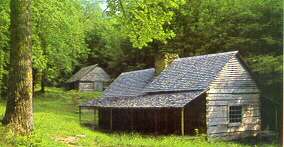Echoes From The Past
By JUDY MAUPIN
*- Echoes From the Past
(A Column of historical and genealogical anecdotes, stories and family notes.)
Calloway County, Ky.
Journey To Kentucky
Jan 6, 1979
History books are written by professional historians in most cases, but history itself is often recorded by the persons to whom it happened. In my opinion, this is authentic history. For this reason, I have often encouraged people to try and record memories and reminiscences of the older members of their families, to save this history for future generations.
I have written (and speculated) in former columns about how the early settlers from North Carolina and Virginia especially, got from their former homes to their new homes in Kentucky. In Edison Thomas' book about the Thomas and Bridges family, he has done a very good job of describing the journey as made by his ancestor, James Thomas IL For the
, next few weeks, I would like to reprint this account.
"The big question, after one wonders why James Thomas migrated to Kentucky, is which way did he travel from Bertie County, North Carolina, nearly 650 miles across a vast forested wilderness to Donaldson Creek in Christian County, Kentucky?
"West was the general direction. Today the journal would be simple enough with a road map and an automobile. In 1806, James Thomas probably followed the crown. By the time he was ready to leave North Carolina for Kentucky, the trail across the state had become well defined. Fact was, the trail was quite distinct all the way to Fort Nashboro, site of present day Nashville. But despite the many settlers who had preceded them, the trail still was not an easy one.
James and Mary Thomas with their six children - Cullen, 15; Temperance, 13; Perry, 9; Starkie, 7; Mary, 4; and James, 2 (Mary was expecting her seventh child in the fall) - left their plantation on the Cashie River, certainly after the March rains were over, most likely in the latter part of April 1806. With them were several of their neighbors including some of the Barnes and Sholar families, all of whom formed a wagon train that moved slowly along the trail near the Cashie River to Windsor. From there the train wound into Edgecombe County, where, at Tarboro, the settlers cross the Tar River by ferry and continued westward across the state.
Within a week they were part of a much larger wagon train, many elements of which had come from the south near Elm City in Edgecombe, now Wilson County. They lumbered slowly along the dusty trail, at best, some 15 miles per day.
Today this trail site is roughly paralleled by U.S. Highway 64 and state route 98 from Tarboro to Durham; U.S. Highway 70 to Greensboro; U.s. 421 via Winston-Salem to Boone, then U. S. Highway 321 to Elizabethton, Tennessee.
In 1806, the trip from North Carolina to Kentucky by oxen-drawn wagons required at least three months depending upon the number of stops along the way. The trip across North Carolina was comparatively easy. From Bertie County, lying on the coastal plain near Albemarle Sound only a few feet above sea level, the trail led gently upward across the center of the Piedmont plateau. At the western edge of the Piedmont lay the Appalachian Mountains.
Formidable obstacle to the trail was that part of the range known as the Stone Mountains. It was a good day's journey to the summit of this range, now part of the boundary between
Tennessee and North Carolina. Usually the emigrants camped at the foot of the mountains and got a fresh start up the steep trail early the next morning.
The trail was not exceedingly difficult to ascend, but when the wagons reached the base of the ridge they were met by a huge rocky escarpment that towered hundreds of feet above them, making it look a bit more terrifying than it actually was. The trip down the mountain on the western slope was more difficult. On many occasions. heavy logs were tied to the rear of the wagons to prevent them from moving forward too fast or rolling out of control into the plodding oxen.
Next week, we will continue this account of an early settler's migration from North Carolina to Kentucky.
I want to thank all the readers who called to tell me how much they enjoyed hearing about Freckles. I would like to comment, though, for those who think they would like to recreate this experience, that it Is not as simple as I might have made it sound. First of all, a bird, in order to become a pet like Freckles, must be raised from a tiny infant, almost out of the egg. Trying to make a pet out of a full-grown bird is almost Impossible. Unfortunately, many people do not realize this until they have acquired one; then they are faced with the problem of disposing of an animal which does not live up to their expectations.
Our experience with Freckles was unique (he's sitting on his heating pad right now, watching me type - he hates cold weather), but not one that I would recommend that others try to copy, unless they know what they are getting into.

